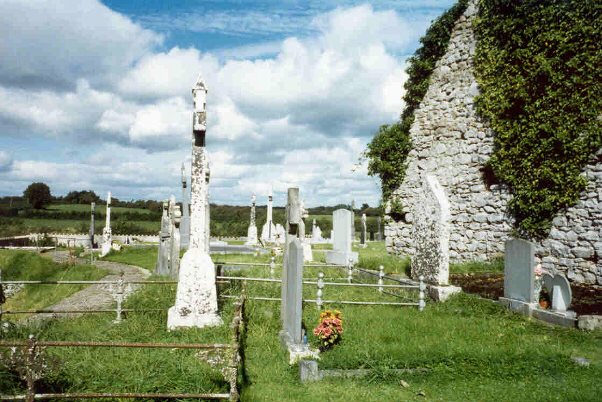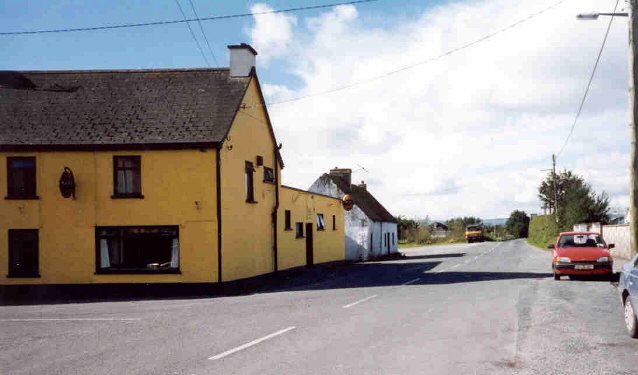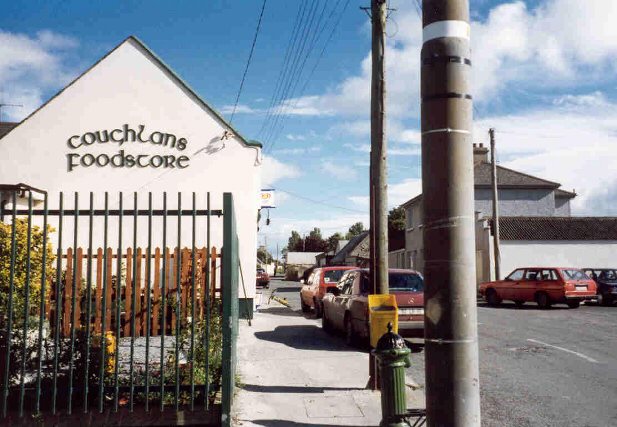Mahoonagh

The church in Mahoonagh (also known as Castlemahon) in County Limerick, Ireland

Looking down the main street in Mahoonagh

Looking the other way down the main street in Mahoonagh
Mahoonagh

The church in Mahoonagh (also known as Castlemahon) in County Limerick, Ireland

Looking down the main street in Mahoonagh

Looking the other way down the main street in Mahoonagh
From a Topographical Dictionary of Limerick City and County by Samuel Lewis:
"MAHONAGH, or CASTLEMAHON:
A parish, in the Glenquin Division of the barony of Upper Connello,
2 miles (S.E.) from Newcastle; containing 3846 inhabitants. This parish
is intersected by the River Deel, and the road from Newcastle to Charleville:
it comprises 12, 262 statute acres, as applotted under the tithe act, which
are in part very good, though some are cold, wet, and stiff, being chiefly
pasture and meadow, constituting several large dairy farms; around the
village is some good land tolerably well cultivated. The marshy land consists
chiefly of exhausted bog, all reclaimable by drainage. The soil rests on
a substratum of limestone, excellent quarries of which are worked at Shauragh
and near the village. The village, which consists of 24 small houses, is
on the eastern bank of the Deel, over which there is a good stone bridge.
The principal seats are Mayne, the residence of Bryan Sheehy, Esq.; and
Ballymakillamore, of Godfrey Massey, Esq. The living is a rectory and vicarage,
in the diocese of Limerick, and in the patronage of the Earl of Devon:
the tithes amount to £500; and there is a glebe of 13 acres at Castlemahon,
and another of 8 acres adjoining the old church yard of Aglish. The Protestant
parishioners attend the church of Newcastle. In the R.C. divisions the
parish is the head of a union or district, called Castlemahon, comprising
this parish and Corcomohide, in which union there are three chapels, situated
at Castlemahon, Foughanough or Feohonagh (both modern buildings), and a
new chapel, erected in 1836 on the road-side between Newcastle and Drumcolloher,
at an expense of £600. Darby O’Grady, Esq., gave £10 towards
the belfry. About 50 children are educated in a national school; and there
are three private schools, in which are about 150 children. The ruins of
a massive square tower, about 30 feet high, exist near Castlemahon
and give name to that village. Near it is a curious circular building,
with a conical roof of stone; it was a strong fortress, erected about 1490
by the Fitzgeralds. Not far from this are the remains of the ancient church.
At Mayne are traces of ancient buildings, supposed to have been ecclesiastical,
though their present appearance indicates that it was a military position;
they most probably formed a stronghold of the Knights Templars, and were
therefore partly military and partly ecclesiastical. There is a church-yard
at Aglish, but no vestige of the church, which was sometimes called Aglish
na Munni.
From http://www.limerickdioceseheritage.org/Mahoonagh.htm: "The present day name of Mahoonagh comes from the Irish 'Maigh Tamhnach', which means 'the plain of the tree stumps' or 'the plain of the clearings'. The village of Mahoonagh is more commonly known as Castlemahon village, although Mainchín Seoighe tells us that the origin of this placename is unclear, there being neither parish nor townland of that name. There is no exact known date for the founding of the parish. In the sixteenth century, Mahoonagh was divided up into three parts called Trean Tawnaghe, Treanmeane and Treanfaltaghe.
Cormac MacCarthaigh became the King of Munster in 1123 when his brother
Tadhg died. According to Mainchín Seoighe, Cormac was known as Cormac
Muighe Thamhnach because he had his residence in Mahoonagh. Cormac was
a violent
leader and led an expedition against the O'Connor's of Connacht. However,
he was displaced as King in 1127 and was killed in 1138 in his house in
Maigh Thamhnach by the O'Briens. Previously, it was recorded that Cellachan,
the King of Cashel was
killed at Mahoonagh in 954."
From http://homepage.tinet.ie/~asduchasdochas/homeweb2/map/info/castlemahon.html:
"Setting out Northward from Dromcolliher we follow for a time the unusually straight road that leads towards Newcastlewest. Passing through the small village of Feohanagh, four miles on, and continuing for another four miles before taking the road to the right, into Castlemahon, a place also known as Mahoonagh.
Michael Scanlon who was born in 1833 emigrated to America with other members of his family in 1848, became deeply involved in the Fenian Movement in the States. He was a prolific-song writer and was also known as the Poet Laurete of Fenianism. One of his early songs tells of his leaving Castlemahon:
"The Valleys never looked so sweet
As on that day
When from my Childhoods blest retreat
I turned away
To breast the Wild and Searching Sheet
The Church of The Monks "Eaglais na Manach"
The Word Eaglais we are told, derived its name from the old Latin word
" "(Ecclesia)" and this church of the monks dates back to the 16th Century.
Aglish at this time consisted of 13 arable acres which was owned by Monks,
who built their monastery there. The Old Church was seen there now was
erected by 1760. It was during 1995 that the "Fine Plaque" Eaglais na Manach
was erected to commemorate the Old Church of the Monks", that was in the
Sacred place during the 16th and 17th Century.
The New Church
On Ascension Thursday, 26 May 1960 his Lordship most Rev Dr Murphy laid the Foundation Stone for a new church in Castlemahon. The Old church which it replaced was built over a hundred years ago. The Foundation must have been faulty as in Canon Irwins time, the pins were inserted to keep the walls Straight. One in each transept Canon Irwin died in 1919. Experts who examined the building considered that it was unlikely that it would hold up any more than a few years and they ordered that the transept galleries should be closed and the gallery should be supported by additional props.
The New Church was blessed and opened by the Bishop of Limerick most
Rev Dr, Murphy on Sunday 3 September 1961. His Lordship presided at a solemn
High Mass and dedicated the New Church to St John the Baptist and to St
Nicholas. A former Curate in the Parish, Rev T Culhane Diocesan organiser
preached a special sermon.
The Old Church
In the Graveyard are the ruins of an ancient Church. During the reign of Queen Elizabeth, persecution of the Catholics continued unchecked and rampant. In 1851 the queens fleet reached the coast of Ireland and made no delay in perpetuating several revolting atrocities up and down the country.
In 1837 the Church on the site of the school was described as a modern
building . According to tradition a thatched building existed in the same
site. The Parochial records begin about 1811
History of Mahoonagh
The Name Mahoonagh comes from an earlier Magh Tamhnach meaning plain of the tree stumps. Early in the 13th Century it was called Maccaveni while old records dated 1288 shows Moycarenagh. In the Civil Survey of 1654-56 the spelling is Mahownagh, Mahoonagh or Castlemahon as we know it, is the parish in the Glenquin Division of the barony of Upper Connello. It is situated two miles southeast from NewcastleWest. The Parish is intersected by the River Deel on the road from NewcastleWest to Dromcolliher. It comprises 12,263 acres which are in part very good, being chiefly pasture and meadow.
The ruins of a massive square tower about 30 feet high, exist neat Castlemahon and gives the name to the village. Near it is a curious circular building, with a high conical roof of stone. It was a strong fortress erected about 1490 by the Fitzgeralds. At Ballynoe are the remains of an old Castle built by the Knights Templers. The ivy clad ruins of Clonelty Church can still be traced beside the old castle.
The Principal seats were Mayne the residence of Bryan Sheehy, and Ballinakillmore
of Godfrey Massey. The Living was a rectory and vicarage of the diocese
of Limerick and in the patronage of the Earl of Devon. Tithes amounted
to £500 and there was a Glebe of 13 acres.
The Castle
Mahoonagh Castle was built by the Fitzgeralds at the end of the 12 or
the beginning of the 13th Century. In later years the Castle was owned
by the Fitzgibbons. The English occupied it but in 1598 another Fitzgibbon
descendant of those who once owned the castle - attacked it and gained
possession of it. There is an interesting story of how this Thomas Fitzgibbon-Macgibbon
succeeded in taking over the Castle. He had a servant named Casey. Nobody
Knows how Casey came to be in the Castle with the English, but on Shrove
Tuesday morning he rose early, he Climbed to the top of the tower unobserved
by the inmates and whistled. This was a signal to Fitzgibbon and the Irish
to get ready. He came down, roused up the porter, Thomas Everard and conned
him into letting him out. Escott, who held the castle, Vosias Walker, Daniel
Jennings the Local minister, and others to the number of forty, were it
is alleged, stripped naked by MacGibbon. Four of them were hanged at the
Windmill of Meane near Kilbolane castle while the rest were allowed to
retire in safety. The other prisoners were ordered to march to North Cork.
As there were more captives than the Irish, Fitzgibbon decided to leave
some of them to be hanged along the way. The English got angry at this
and Fitzgibbon was forced to set all the prisoners free.
Baptist Well
Baptist well situated at Cooliska is widely known for cures affected there during the "Paying of Pounds", especially in the cases of eye disease.
One of the most famous cures was that of Dean O’ Brien late of NewcastleWest.
He suffered from blindness as a child and his brother brought him to the
well. She did the ‘rounds’ with the child on her back, on the completion
of the third round the childs sight was restored. Up to this time the childs
name was Richard and in thanksgiving his mother called him Richard Baptist
from then on. It is told St Patrick passed this way fifteen hundred years
ago and for the first time told the story of St John the Baptist and dedicated
the well to his memory.
White Well
The White Well is the townland in Moanroe. In olden times rounds were paid there and one parishioner is known to have been cured at the well. Legend tells us when a woman washed clothes at the well it moved. The White Well was taken over by the County Council in 1973. It can supply a half million gallons per day. The well is supplying the parish with water as well as, some of the surrounding county districts.
Castlemahon Foods
Poultry processing in Castlemahon commenced in the late 1920’s and comprised
of the gathering of live fowl for both the home market and for export.
The business grew to become the leading poultry business in Ireland in
the 1960’s."
To go to the Mahoonagh parish website, click here.